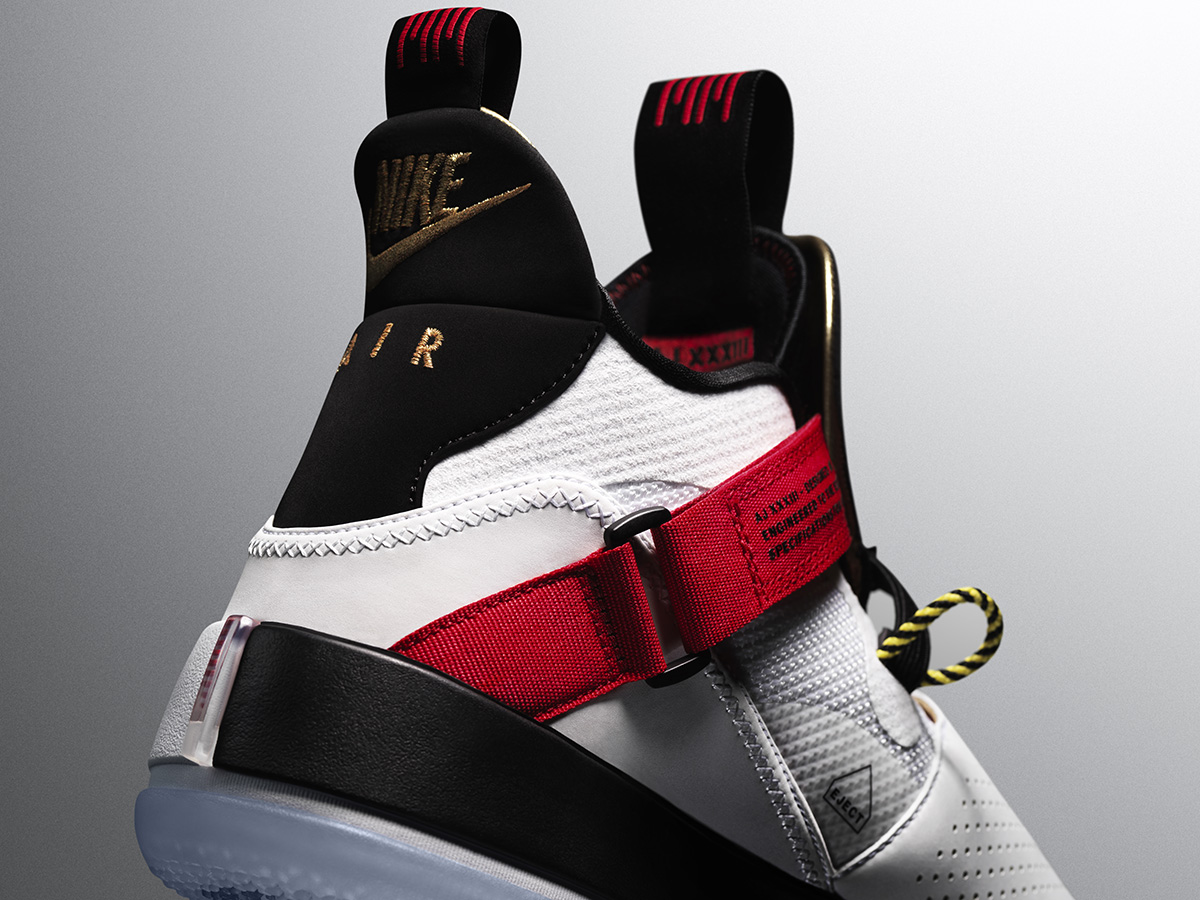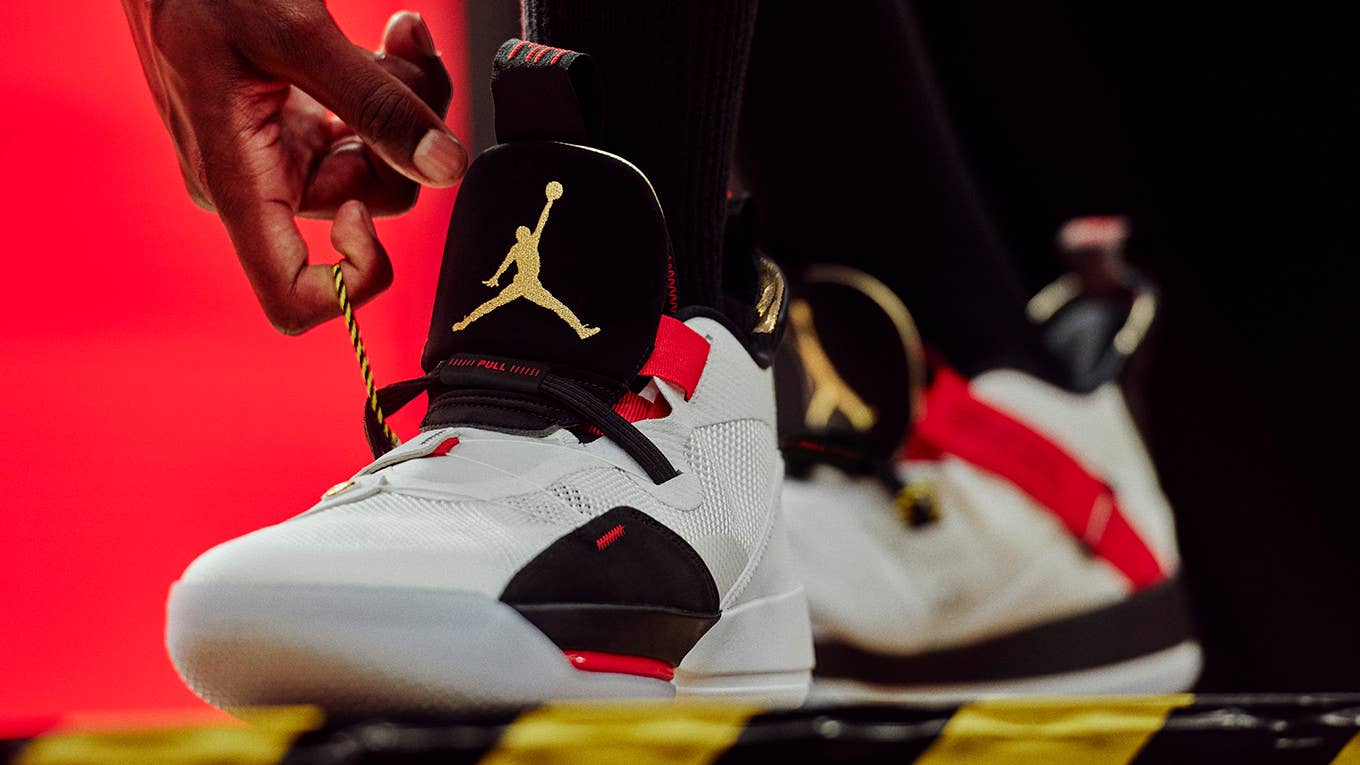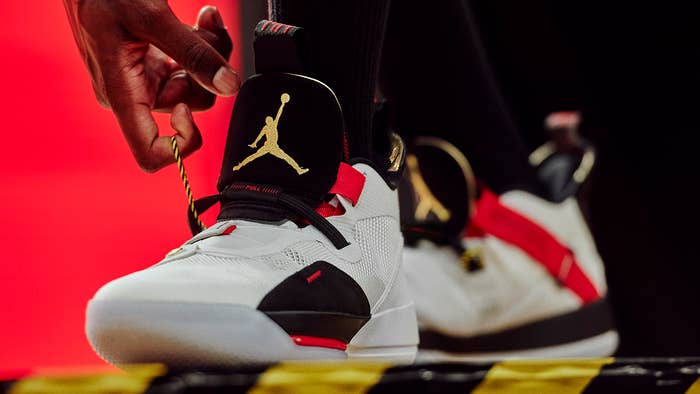
Jordan sneaker designer Tate Kuerbis was a little nervous when he brought his idea of the Air Jordan 33 to Michael Jordan. After all, debuting an in-game flagship AJ model without laces was a bit outside the norm. “Hey, Michael, what do you think about a basketball shoe without laces?” was how Kuerbis remembers it. “The more we explained the benefits of the technology, MJ is one of those people always wanting to push something.”
Before settling on a laceless design, Jordan needed to know it would work. Kuerbis needed to know how it would work. So, it was up to the engineers in the Nike Sport Research Lab, led by Austin Orland, to make this brand-new “FastFit” non-lacing system function. Then, Kuerbis and the design team had to weave FastFit into the Air Jordan line as the pinnacle focal point of shoe 33.
The Technology
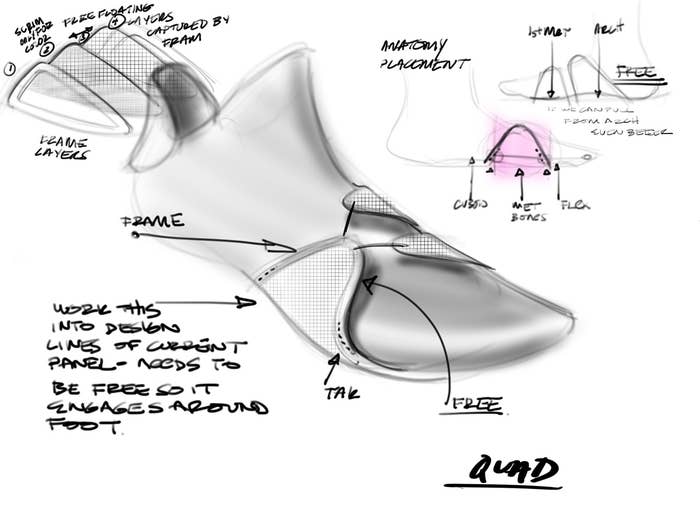
The 33 has two stories: technology and aesthetics. And they both center around the fact that for the first time in the Air Jordan line, you won’t find a single lace on the sneaker. “We really obsessed the details of how we are going to communicate this to the consumer,” Kuerbis says. “They are going say, ‘Where the fuck are the laces?’”
Everything hinged on the technology, so Kuerbis found inspiration for the entire AJ33 based off NASA design—David Creech, vice president of design at Jordan Brand, also used that concept throughout the brand’s upcoming apparel and footwear lines—playing off exposed elements, just like you’d see on a space suit.
Enter FastFit. The system works by weaving 10 inches of ultra-high molecular weight polyethylene cable (think: the same material used in parachutes and as Kuebris puts it, “This is not some off-the-shelf Home Depot cable [throughout the sneaker]." The cable runs through an elastic pull tab across the top of the shoe. Pulling the strap tightens the cables. The addition of a heel strap offers both additional support on the back of the mid-top, as well as providing a bit of a mental support that the shoe will stay snug with the tangible tightening point.
In keeping with the NASA-style exposing of technology, portions of the cable fall on the outside of the sneaker and other parts tuck inside.
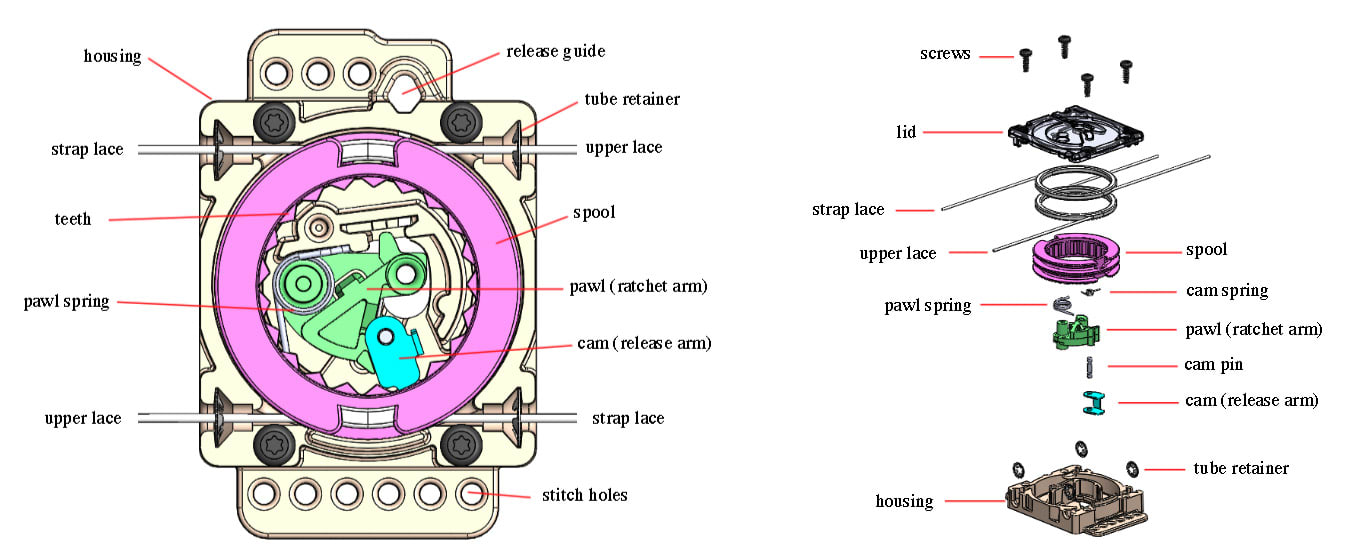
It took years of testing the FastFit system to get it ready for a game shoe. Jordan Brand wanted to bring it directly into the Air Jordan, embracing the tradition of technology debuting in the line, from becoming the first basketball sneaker to make Air bags visible or to feature variable lacing, to the first to offer carbon fiber plates.
Even with the testing and the science behind the system leading the entire design team to 100 percent positivity they created something “amazing,” releasing a finished design to the public scares Kuebris, even just for the effort put in. “I can’t express to you how much work we put into this shoe,” he says. “It was unbelievable. I kinda want to cry right now. There were so many nights of going to the factory in Asia, just trying to put it on and figure out how to lockdown. It was a huge project and there were a lot of creative forces behind the shoe, a world-class team.”
Along with the elastic pull tab that engages the cables and tightens the mechanism—the harder or more you pull, the more “clicks” the cables tighten—a small eject cord releases the tension. With up to 12 clicks available, athletes can find the perfect fit for them. Obsessing over the details allowed the design team to “geek out” on the tech. Moving the cables just a couple of millimeters impacted the entire lock-down feel.
Testing of the fresh technology played heavily in the process. Whether Maya Moore or Kawhi Leonard, the shoe was examined at the ultimate level. “We have done our homework,” Kuebris says. “There was a definite trial and error. There were tears and fun when you get to the finish line. It is exciting.” Kuebris also hopes the lack of laces becomes part of the athlete routine, possibly seeing athletes grab the pull tab just before entering a game.
The Aesthetics
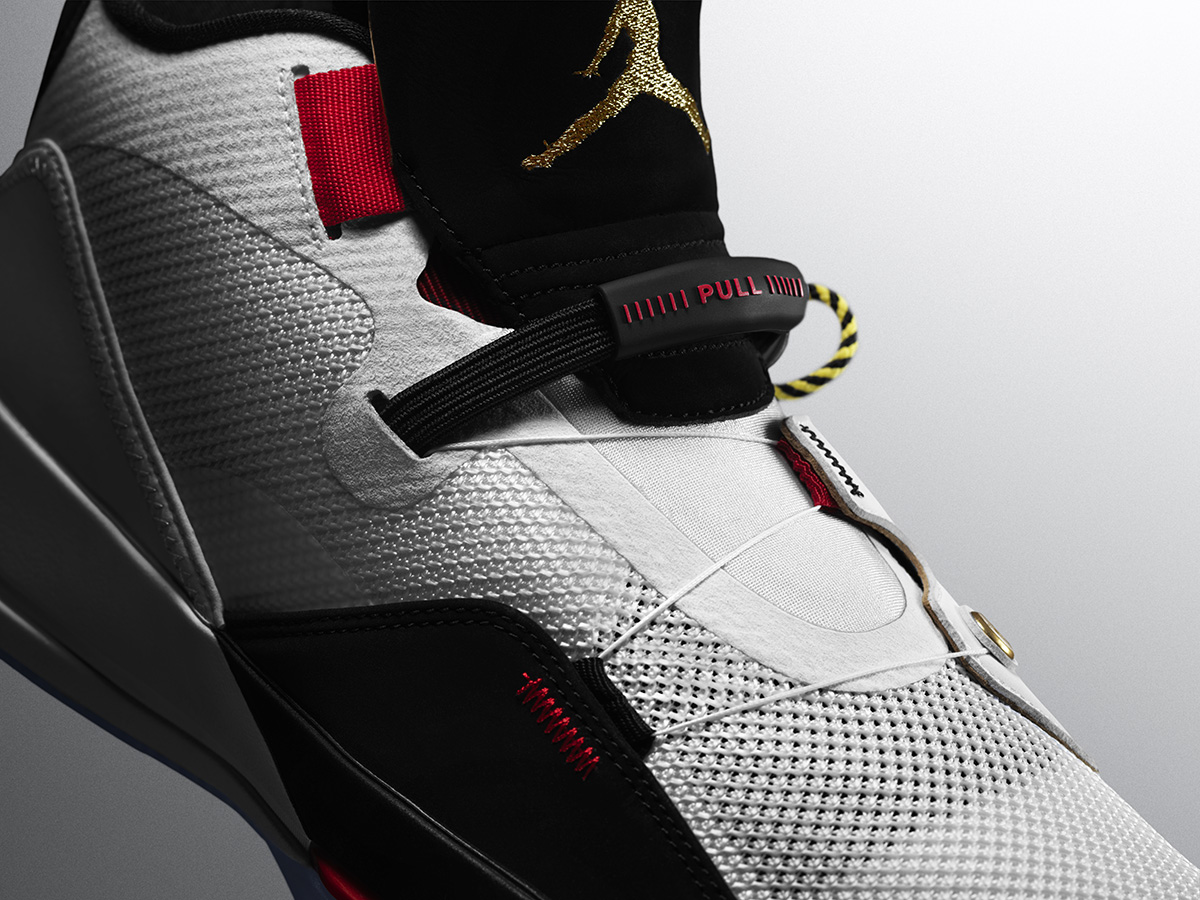
Kuebris’ team didn’t want to overcomplicate the design, instead wanting the FastFit to remain the star.
“With the Jordan game shoe, there is an element of sophistication,” says the designer of the AJ17, AJ18, AJ31 and AJ32. “We want it to be fun and expressive, but something that 10 years from now still looks like a great shoe. We wanted to express performance technology to the consumer in an Air Jordan way, more refined.”
After talking to MJ, the team decided to more directly highlight the technology, exposing the forefoot panel lockdown. “We had to have part of it on the outside and part of it on the inside,” Keubris says. “It was not easy to do, but we pushed to make it work and I think it ended up being a really cool feature of the shoe. When you engage it you see the whole system working.”
Using the circular FastFit mechanism placed in the shoe’s outsole, Kuebris exposes the technology through the clear outsole — the red outlines on the forefoot and heel mimic that NASA aesthetic by calling out the locations of Zoom Air on the 33. The translucent outsole also includes a new lighter weight traction pattern with mini traction fingers ala the Kobe X.
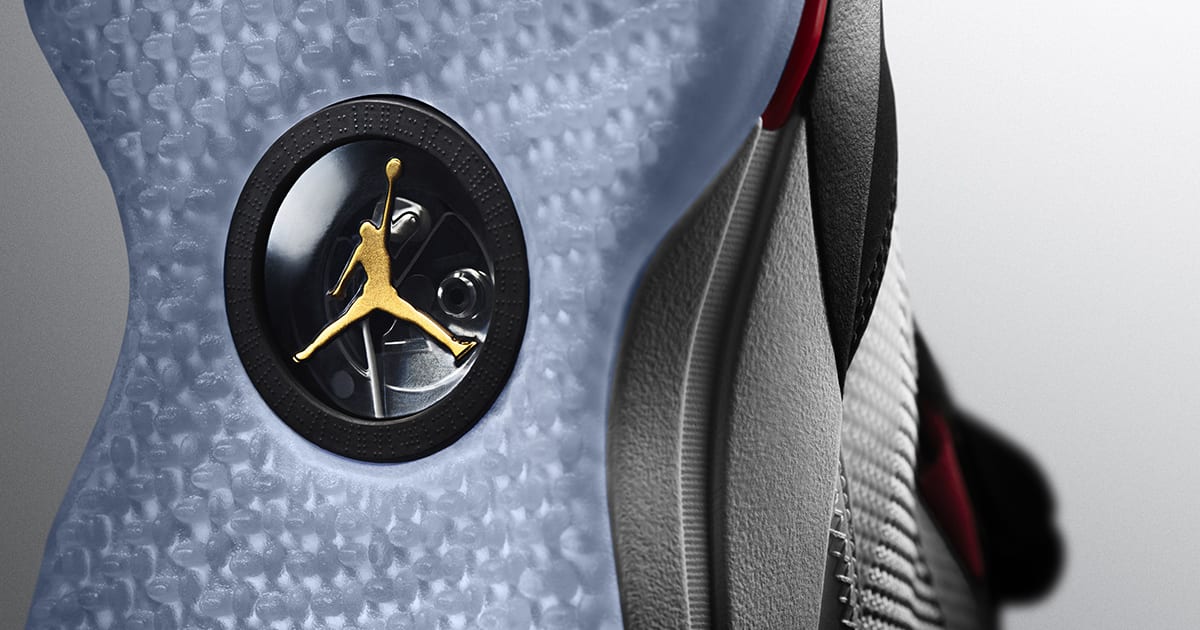
Along the way, Creech says they were careful not to craft a futuristic shoe, but give modern culture “flight utility” by merging the freshness of FastFit with materials already familiar to the consumer. So, expect a mix of off-the-shelf materials previously associated with the Jordan line, such as overlays in leather. The team retains the ability to change out the textile upper, if they want to create a completely different aesthetic. “It goes back to the space suits,” Kuebris says. “The material was what it was, it was functional and it was designed that way. We took the same approach on the shoe. They are honest materials.”
With the laces vanished, replaced by cables and overlays, Kuebris plays up a massive tongue with the Jumpman logo and a “heel pringle” meant to accent the easy in and out of the sneaker. Even those elements, which Keubris calls expressive, fall in line with high function. Woven labels on the tongue and cushion pods on the heel ensure “every piece expresses, as much as possible, the way it functions.”
The eject cord comes in yellow and black to mimic that of jet fighter pilots.
Then, to add refinement, the place where the cable terminates and ties off, located on the top of the foot, you’ll find a gold Jordan-detailed button.
Throughout, Kuebris says, they embraced craftsmanship, using leathers and intricate stitching patterns. Add in the fact that shoe makers have to use a hook to fish the cable throughout the sneaker and Keubris says it is “amazing the high level of craft that goes into the shoe.”
Adding a little fun and more NASA to the mix, the back heel mimics NASA rocket designs, adding a small notch on the exterior outsole. “We were looking at rockets and they have these icons on them that tell you don’t step here, this will burn your hand or explode if you touch it,” Kuebris says. “This was one of the funky icons you will only see in an Air Jordan.” The graphic call-out on the heel ledge signifies the 15 feet Jordan jumped from the free throw line in the original AJ3.
While many folks expected the 33 to fall in step with the 31 and 32, both paying tribute to the AJ1 and AJ2, respectively, the 33 becomes its own animal, with only small details harkening to the 3, whether the free throw dunk remembrance or the Jumpman logo on the tongue.
“It is not so much the fact that we are trying to recreate the 3 in a new ‘Flight Utility’ way, it is only respecting the past and representing what MJ was doing back then with the 3 and the slam dunk,” Kuebris says. “It was more an inspiration.”
The Colorways
